Role of AI in Construction: Boost Efficiency & Sustainability in Canada
Ditstek Blogs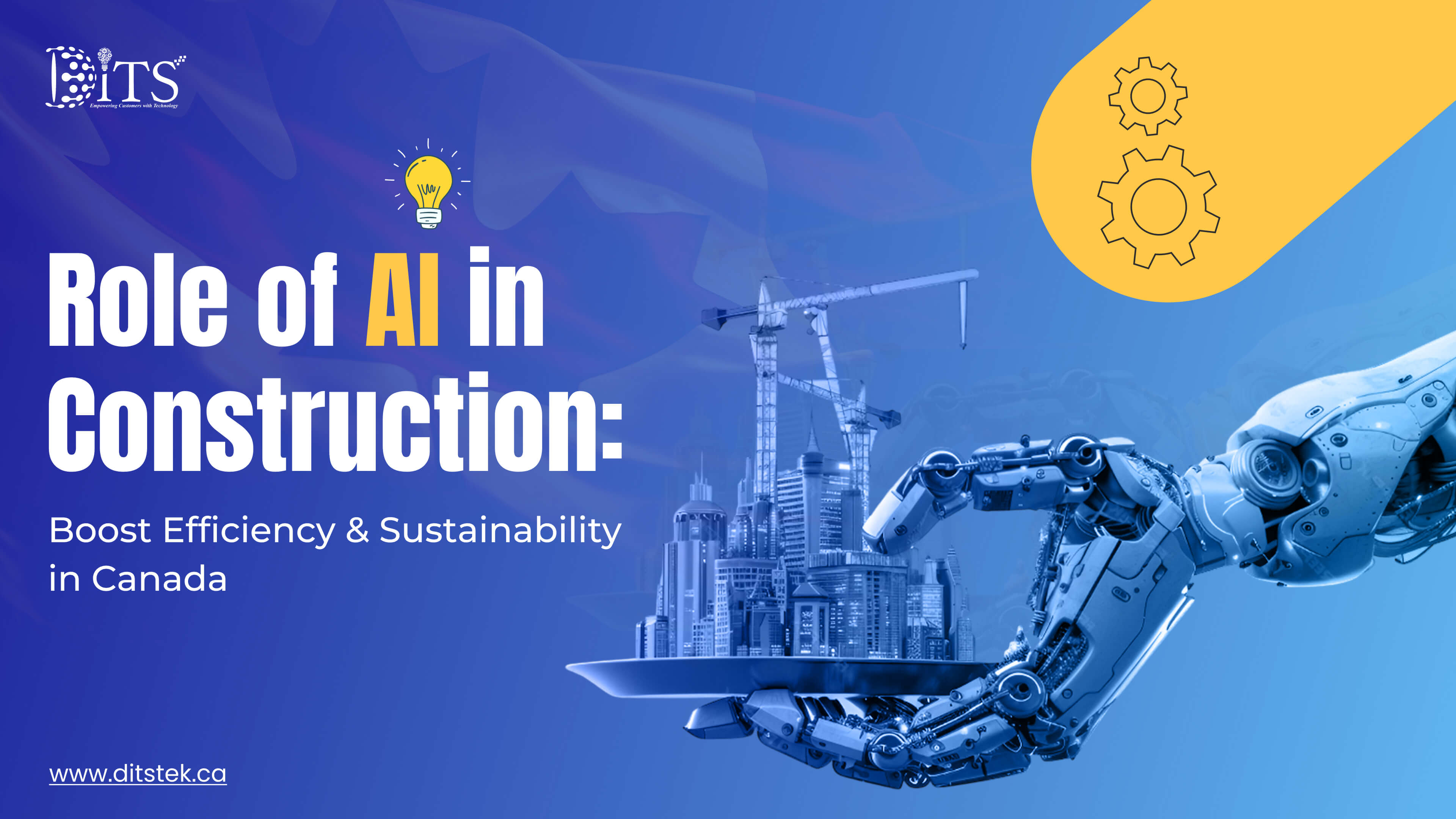
Construction projects are getting bigger and more complex around the world, and the old ways of managing them fall short of meeting the demands for efficiency and accuracy. This is where AI comes in, and it's actually changing how we construct buildings and structures.
AI is now involved in everything, from early brainstorming sessions where architects sketch out ideas to checking buildings years after they're finished. It's everywhere in construction these days, especially in an industry that has been working in traditional ways for decades.
What's really cool is how AI uses all sorts of tech to make things better. We're talking about innovative computer programs that learn as they go, systems that can look at images and understand what they see, and even voice recognition stuff.
All of this helps construction teams figure out the best way to use their resources. It cuts down on those annoying delays and saves money, too. But here's the thing that really matters: it's making job sites safer for workers.
Here's a practical example: AI can dig through terabytes of data from old projects and basically predict what might go wrong. Instead of being surprised by problems, construction teams can prevent them early. This blog shares the role of AI in construction and how it helps improve efficiency and sustainability.
AI in Construction: Why the Industry Needs It?
The construction industry is changing quickly with technology, but it's not always easy to adopt new technologies when you have many deadlines. This is where AI comes in.
Artificial intelligence is poised to become the next breakthrough technology that benefits everyone: the workers on the job, the companies that employ them, and the end clients. For construction companies looking to ensure maximum efficiency, adopting AI will become mandatory.
So what can it do? AI can take over tedious, repetitive tasks, allowing workers to focus on areas that actually matter, such as safety, quality, and productivity. It puts time back in people's hands to use their own experience, expertise, and creativity in design and planning, rather than getting mired in repetition and routine.
AI can also help construction companies predict potential problems and issues, and help keep workflows running smoothly. Let's take a look at how this outstanding technology is already making a positive impact on the construction industry.
Want to Future-Proof Your Builds?
Learn how AI integration in construction helps you stay ahead — smarter design, safer sites, and sustainable execution.
How AI Helps Improve Efficiency in Construction
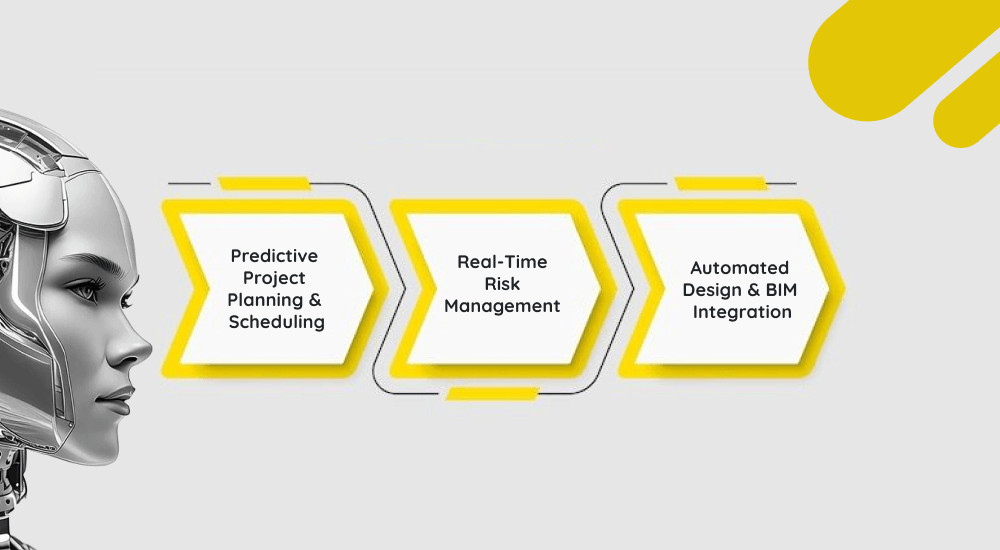
Improving productivity has always been a critical factor in construction. Even a minor delay in one part of the schedule ripples through the entire project. However, it is now possible to anticipate that delay before it ever happens. That is the power of AI in construction, helping real estate companies to manage time and resources more effectively.
AI-driven tools are now enabling construction project teams to plan, track, and execute task activities with high accuracy. Algorithms analyze real-time data from sensors, drones, and machinery to help construction project supervisors identify bottlenecks early in the execution phase.
Predictive Project Planning & Scheduling
The problem with construction schedules is that they are often changing mid-execution due to bad weather, supply delays, or substantial design changes. If a condition changes, AI can predict the risk to completion and adjust accordingly, using historical data and real-time updates.
It learns patterns to job conditions, forecasts labor requirements, and adjusts schedules on the fly. Teams can look into innovative AI-based systems that respond to changing conditions rather than relying on crafted schedules.
Real-Time Risk Management
Safety is crucial in the construction industry. AI cameras and sensors can now identify risk-prone behavior, monitor the health of tools and equipment, and even notify management about hazards before an accident occurs. By identifying risks in advance, predictive information saves lives and money.
Automated Design & BIM Integration
Design conflicts used to appear late in the design process—usually after it becomes expensive to fix them. AI is now integrated with Design Information Modeling (BIM) systems to identify clashes early, suggest design enhancements, and even automate parts of the modeling process. Architects, engineers, and contractors now work more effectively together, significantly reducing time and costs.
The real beauty lies in how these systems work together. When AI predicts scheduling delays, design tools automatically adjust resource plans. When risk-detection systems flag a hazard, workflows are rerouted in real time. It's the innovative business workflow automation in action.
And at Ditstek Innovations (DITS), we've gone a step further. We use artificial intelligence not only in construction but also across other industries, including healthcare, retail, mining, and transportation. Every software we develop integrates AI capabilities that evolve with our clients' needs.
Benefits of Using AI in the Construction Industry
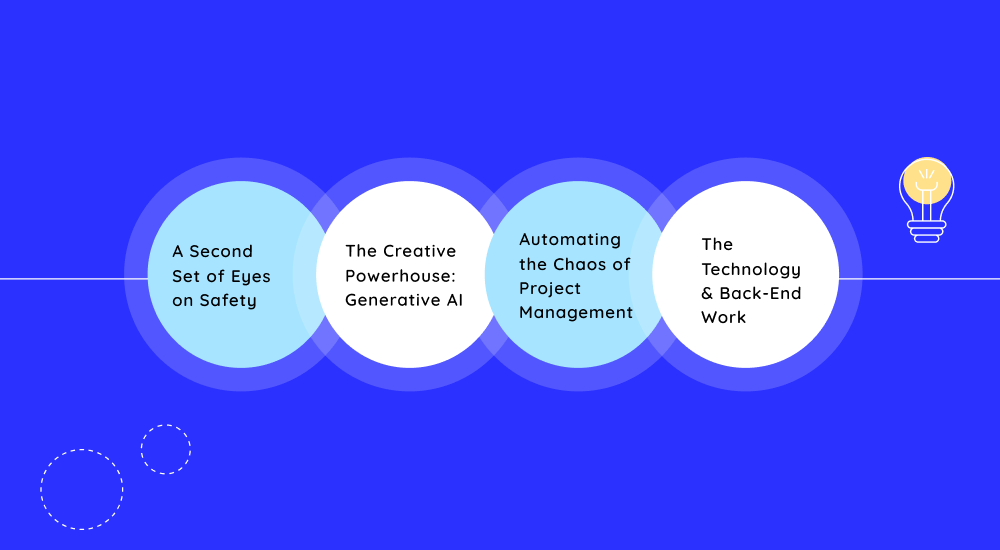
The benefits of using AI in construction cannot be put into words. However, here are the key advantages of using this outstanding technology to build modern structures.
A Second Set of Eyes on Safety
One of the most significant advantages of AI in construction is increased job-site safety. It prevents worker accidents on construction sites through continuous surveillance.
Continuous Monitoring - Picture an AI-based camera system that is always watching for safety, potentially risky behavior. Someone is not wearing a helmet, or a piece of equipment is left in the wrong position.
Predictive Hazard Detection - The system learns what a "normal" day looks like and recognizes anomalies that are typically predictive indicators of a problem. Again, AI doesn't get fatigued or distracted.
Automated Alerts - This is a perfect example of business workflow automation. The system sends an automatic alert to a site manager's phone the second it sees something wrong. No waits, no manual checks, or verification.
The Creative Powerhouse: Generative AI
Things start getting really wild and the most futuristic. Instead of merely analyzing, AI is now working to help create.
Turbocharged Design: With generative AI in construction, an architect can provide their constraints - budget, location, materials, even goals like "maximize natural light" - and the AI can produce hundreds of viable, optimized designs that are less than a couple of minutes from the architect's original conceptual intent.
An Inventive Partnership: It frees the human team to learn about the possibilities they would never allow themselves the time to explore manually. The AI handles the challenging drudgery of drafting and modeling, while the architect hones the creative vision.
More Intelligent from the Beginning: The AI-generated plans are automatically optimized from the earliest concept, considering factors such as energy efficiency, structural integrity, and even foot-traffic flow.
Automating the Chaos of Project Management
To be candid, construction projects are complicated. AI can help alleviate the challenges of construction project management by imposing order on complex processes.
Delay Prediction: AI can analyze variables spanning supply chains, weather, and worker efficiency to highlight potential sources of delay before they occur and before delays substantially slow the project. This information promotes proactive problem-solving.
Quality Control 2.0: Building on advancements in computer vision and AI, AI can analyze a finished wall or foundation, scanning for tiny imperfections or cracks that may be missed by human observation, providing improved quality assurance for a project deliverable.
Resource Efficiency: AI manages when workers arrive at the job site, when to place material orders, and how many workers are needed overall. It is the ultimate resource manager in the field.
The Technology and Back-End Work
Naturally, these amazing tools don't just materialize. They have been created by people immersed in this industry and know it forward and backward.
Specialized Development: It all comes down to sophisticated AI software development. You need teams capable of building algorithms that understand the challenges unique to a construction site.
Industry Specific Innovators: This, in part, is why you see a lot going on from real estate software development companies. They understand the entire project lifecycle, from the ground up, and can build integrated platforms to connect all the dots.
Ready to Rebuild with Intelligence?
Discover how AI-powered development can cut costs, enhance precision, and modernize your construction operations across Canada.
How DITS Supports AI-Driven Construction Transformation
At Ditstek Innovations (DITS), we believe the construction industry deserves more than off-the-shelf solutions. That's why we bring together technology, data, and experience to help Canadian businesses reap the full potential of AI in construction.
Our team has spent nearly a decade developing intelligent solutions for industries that build, move, and grow; from real estate and manufacturing to logistics and energy. We don't just implement technology; we make it work for your people. Our approach is hands-on, transparent, and tailored for long-term scalability.
At DITS, we use AI for software development, quality assurance, and maintaining high code standards. Every project we build is infused with AI-driven intelligence. We also integrate business workflow automation into our custom applications, ensuring your teams spend less time on repetitive tasks and more on strategic work.
And because construction is as much about trust as it is about technology, we've built relationships that last. With a 97% client retention rate and 100% project satisfaction, DITS continues to be a partner Canadian enterprises rely on for innovation that delivers value.
Whether you're a real estate software development company exploring more innovative property management or a contractor aiming for energy-efficient builds, we help bridge the gap between traditional construction and intelligent automation.
Conclusion
The construction industry in Canada is entering a defining era; one where precision, sustainability, and intelligence matter more than ever. Artificial intelligence not only digitizes workflows but also changes the way entire projects are conceived, delivered, and managed. However, to leverage the full advantage of AI, real estate companies need a robust AI solution developed by a custom software development company. DITS provides custom software development services tailored to the specific needs of construction businesses.
Companies that make the jump now won't just catch up, they'll lead. They'll complete projects faster, use resources smarter, and build structures that last longer. But more importantly, they'll foster an organizational culture of innovation, where data guides decisions, and every improvement compounds over time.
FAQ’s
1. How is AI transforming the construction industry in Canada?
AI is facilitating Canadian construction firms in their planning process by giving them the ability to make better decisions, speeding up the whole construction process, and helping them to conserve their resources. By converting raw data into actionable insights, AI empowers companies to save time, reduce costs, and deliver high-quality projects.
2. What are the most common uses of AI in construction?
AI's applications include predictive maintenance, automated design through BIM integration, cost estimation, safety monitoring, and material optimization. Additionally, it backs project forecasting, aids in the management of equipment usage, and contributes to the enhancement of overall operational efficiency.
3. Can small or mid-sized construction businesses afford AI integration?
Definitely, AI used to be considered a tool for large companies only, but now the situation has changed, and smaller companies can also make use of it due to the availability of scalable tools and cloud-based solutions. Some of them start with basic integrations; for example, predictive analytics or workflow automation, and then gradually move up the ladder as they get measurable returns.
4. How does AI support sustainability in construction?
AI not only decreases our total environmental footprint due to its capabilities of energy optimization, material demand forecasting, and real-time monitoring of carbon emissions but also makes sure that all the buildings are up to the mark as per the sustainability requirements of LEED besides assigning eco-friendly sourcing and helping projects to meet Canada's Net-Zero 2050 targets.
5. What is generative AI in construction?
Generative AI in construction is the term used for the machines that are capable of creating building designs or layouts automatically according to the given conditions—such as financial limits, site limitations, and energy-saving requirements. It tests numerous options at a time and selects the most environmentally friendly and cost-efficient solutions within a time period.
6. How can DITS help my business adopt AI?
At DITS (Ditstek Innovations) we have the capabilities to provide a complete AI-based software development service for construction and real estate firms. The team will collaborate with you to integrate AI into your bespoke application for reasons such as: improving the efficiency of workflow through automation, real-time monitoring of performance, and deriving predictive insights.

Dinesh Thakur
21+ years of IT software development experience in different domains like Business Automation, Healthcare, Retail, Workflow automation, Transportation and logistics, Compliance, Risk Mitigation, POS, etc. Hands-on experience in dealing with overseas clients and providing them with an apt solution to their business needs.
Recent Posts
Get in touch



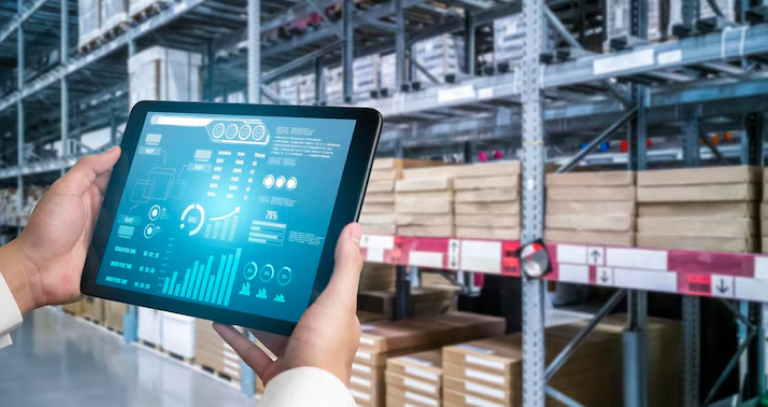




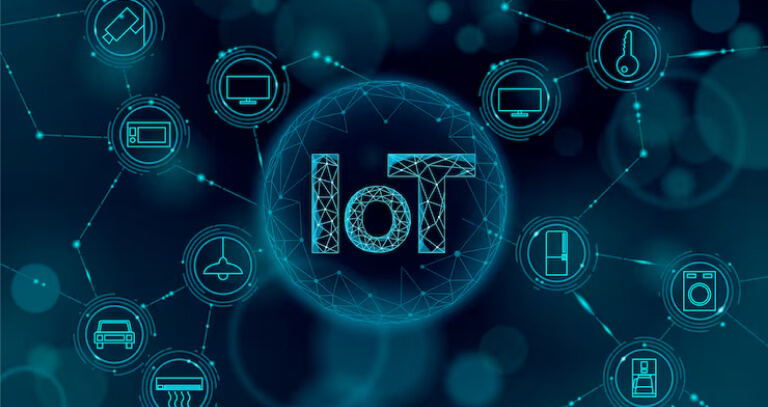


 Calgary | Edmonton | Vancouver | Toronto
Calgary | Edmonton | Vancouver | Toronto